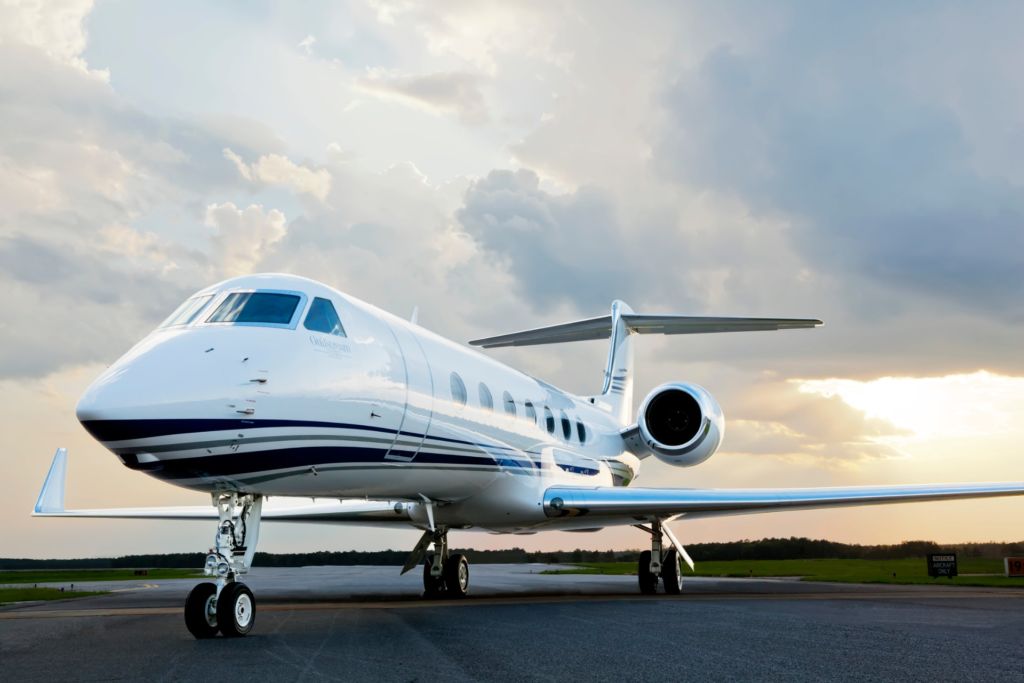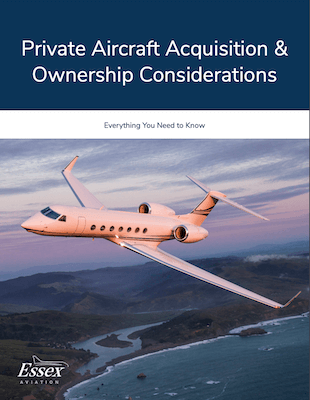
An aircraft pre-purchase inspection, or a pre-buy inspection, refers to the process by which a qualified entity or inspector examines an aircraft during a potential sale or transaction. The inspection aims to identify any pre-existing damage, potential maintenance issues, non-conformity of aircraft records and so on in order to protect the buyer’s interests.
The Importance of an Aircraft Pre-purchase Inspection
It’s critical for a buyer to request an inspection before they buy, rather than find out after the fact that there’s an issue with the aircraft that an inspection would have revealed.
Purchasing private aircraft is a major investment, and aircraft are often marketed as being in perfect working order. But even known issues that the seller discloses, which at first impression may appear minor, will often incur more cost to remedy than expected. Therefore, it’s in a buyer’s best interest to conduct a quality pre-purchase inspection as part of the acquisition process. It should also be noted that if deferring a proper pre-buy is being considered, issues and discrepancies could be revealed during the next sale of the aircraft, which the owner will then have to remedy out of their own pockets.
Besides identifying routine repairs, some discoveries during a pre-buy inspection can rise to a level of safety concern for the ongoing operation of the aircraft. Observations during a pre-buy inspection may also reveal potential issues that could influence future dispatch reliability or availability of the aircraft for the new owner due to large scheduled maintenance requirements. Naturally, all of these are good things for a buyer to know.
It’s not unusual for the current owner to believe that their aircraft is in pristine condition, especially if they’ve recently invested in upgrades to the aircraft or have files of expensive maintenance receipts to show for it. Even with good intentions and support provided by the current owner or their broker, certain items or areas of the aircraft should and will be sufficiently reviewed during an aircraft pre-buy inspection.
At a glance, here are the benefits prospective buyers can expect from a thorough pre-purchase inspection:
- Pre-purchase inspections enable buyers to make more informed purchasing decisions by giving them the opportunity to determine the actual status of the aircraft and compare it against the buyer’s expectation and the seller’s representation.
- Aircraft pre-purchase inspections can help ensure the buyer’s safety by assessing the airworthiness of the aircraft and identifying any outstanding issues that might compromise its safety or integrity.
- Should the pre-purchase inspection flag certain issues with the aircraft, the buyer and their team of representatives might use this information to negotiate an adjustment to the purchase price or more favorable terms. At the very least, the buyer and their team should request that the seller address any necessary discrepancies prior to the purchase. Depending upon the nature or severity of a discovered discrepancy normally defined within a Purchase Agreement, the buyer may choose to reject the aircraft and terminate the transaction.
- Even though the cost of an inspection is normally the buyer’s responsibility, an aircraft pre-purchase inspection is a pragmatic move because repairs can take considerable time. Identifying and addressing existing or potential issues prior to purchase is an excellent way for a buyer to help ensure that they’re able to fly the aircraft worry-free for some time after the purchase is complete.
When a pre-buy inspection and purchase is completed and a buyer becomes an owner and eventually wishes to market the aircraft, one can take comfort that a quality pre-buy inspection took place while they were the previous buyer. In many cases a future buyer considers the prior pre-buy report a positive addition to the aircraft records which will assist in their inspection and transaction process.
Primary Objectives of a Pre-purchase Inspection
Aircraft pre-purchase inspections are designed to achieve the following:
- Assess the overall condition of the aircraft and verify that all specifications, including equipment, align with what the seller has represented
- Assess the aircraft, looking for any signs of damage or prior repairs that were made that could impact the assumed value or airworthiness of the aircraft
- Ensure that the aircraft conforms to all the necessary regulations for the country in which it will be registered and operated
- Review all maintenance and inspection records to ensure that they are accurate and current, and that the aircraft has been maintained in accordance with the manufacturer’s approved inspection program
- Identify any missing records or documentation preventing component traceability
- Determine if findings during a pre-purchase inspection could affect airworthiness or impact the assumed purchase value of the aircraft
- Provide and communicate a complete technical report of the pre-purchase inspection to the buyer
Potential Issues an Aircraft Pre-Purchase Inspection Can Reveal
To illustrate the importance of an aircraft pre-purchase inspection, let’s look at some of the possible issues that could come to light during the inspection process:
- Although inoperative cabin systems — such as cabin entertainment, window shade controls and galley equipment — might appear to be minor issues, they are systems that are included and part of the certification process of the aircraft. Costs can increase exponentially if replacement parts or components for some systems are becoming obsolete and more costly to repair. If discovered during the aircraft pre-buy inspection, inoperative cabin systems would normally fall upon the seller to correct.
- Aircraft are designed under strict certification. During the aircraft pre-buy inspection process, it’s not unusual to discover that certain refurbishments, modifications or upgrades made to the aircraft were not properly certified or cannot meet approval — an issue that can take a long and costly process to rectify.
- Any aircraft that has undergone a major repair or has been modified has an extensive list of FAA required documents, including Instructions for Continued Airworthiness. During the pre-buy inspection process, an inspector’s job is to confirm these documents are present and incorporated into the aircraft’s required inspections.
- An aircraft that was subject to damage and subsequently repaired might mandate separate ongoing inspections that are out-of-phase with its normal scheduled inspections. An inspector would ensure any such inspections, if applicable, have occurred properly and are made known to the buyer. Normally, any separately tracked or abnormal inspections must be disclosed by the seller.
- The type of inspection program for an aircraft can vary based on its current operator and utilization. In cases of very high or very low utilization, there may be a necessary process to transition the aircraft back to the normal manufacturer’s inspection program — a process that can be costly and should be disclosed to the buyer.
Common Misconceptions Around Pre-Purchase Inspections
Some buyers make the mistake of assuming that, since the aircraft recently underwent a major inspection, there’s no need for an aircraft pre-buy inspection.
Although it’s true that a recent major inspection might turn up some useful information about the aircraft, most scheduled inspections only address a portion of the aircraft’s current condition based on a predetermined checklist. Aircraft pre-purchase inspections should be uniquely designed to specifically examine and target the areas of greatest concern and have been proven to reveal trouble spots within a specific aircraft model.
Another common misconception is that an aircraft pre-buy inspection report is unnecessary for an aircraft that’s only a few years old. Newer aircraft models naturally are of a higher value than older models, which means any issues discovered with a newer model could have a greater monetary impact on the presumed value of the aircraft than with an older model.
Even after just a few years of operation, an aircraft’s environment and operating history might have been detrimental to its presumed condition and market value. Furthermore, if the aircraft is still under warranty, any issues discovered during the aircraft pre-purchase inspection may still be covered and resolved under the manufacturer’s warranty.
Finally, buyers often assume that an aircraft pre-buy inspection is unnecessary when the aircraft in question has a strong maintenance pedigree — a common example is if the aircraft were previously owned and operated by a Fortune 100 company.
Although a corporation’s ownership may suggest high standards and that the aircraft was kept in mint condition, this may or may not be the case. Some corporations may have limited their aviation department budgets, which could result in the deferral of normal planned upgrades, timely refurbishments and, in some cases, even incorporating highly recommended service bulletins.
For all of the reasons outlined above, the importance of performing an aircraft pre-purchase inspection really can’t be overstated.
Aircraft Pre-Purchase Inspection Process
Although the actual process may vary depending on the private aviation professionals a buyer works with and their specific goals and requirements, the general pre-purchase inspection process will be carried out as follows:
- Preliminary Inspection: When a candidate aircraft is identified, a licensed mechanic or other qualified professional will perform a high-level review of the aircraft and its records to assess its overall condition, flagging any apparent issues or early concerns that could be show-stoppers. In some cases, critical missing records will be a red flag. A preliminary inspection may also reveal physical damage or visible corrosion to the aircraft or other evidence of poor maintenance in general.
- Work Scope: If the preliminary inspection indicates that the aircraft is a good candidate, the buyer’s representative will create a plan to continue the evaluation process. At this time, the buyer should discuss with their representative how to select the best maintenance service facility to perform the pre-purchase inspection. Ideally, a service facility will have no history of that aircraft or a relationship with the seller. Once a service facility is decided, the owner’s representative and the service facility together should craft a pre-buy inspection checklist designed to the uniqueness of that aircraft.
- Arrival Inspection: Upon relocating the aircraft to the maintenance service facility, technicians will conduct a comprehensive evaluation of the aircraft’s engine, avionics systems and other components to confirm the aircraft is ready to conduct a test flight. A variety of functional tests can be accomplished on the test flight.
- Inspection Input: At this stage in the process — and after the test flight — the aircraft is placed in a hangar to continue disassembly, detailed inspections and remaining functional checks.
- Documentation Review: Documentation review takes place concurrently with the physical inspection of the aircraft. Documentation review is essentially a thorough review of the aircraft’s production, maintenance, inspection history, alteration and repair records, and any other documents pertaining to the aircraft’s history and operation to ensure that they are complete and accurate.
- Final Report: The maintenance service facility summarizes its findings, including information about discrepancies in need of repair or missing documentation, so that the buyer can be fully informed. Based on this information, the buyer would accept the aircraft based upon the seller’s remedy of necessary discrepancies. Should issues arise, it is sometimes reasonable to negotiate an adjustment of the sale price of the aircraft or, if desired and if allowed by the Purchase Agreement, a buyer can reject the aircraft and walk away from the purchase entirely.
Aircraft Pre-Purchase Inspection Tips
To set yourself up for a successful process, follow this aircraft pre-purchase inspection guidance:
Set Realistic Expectations
When purchasing a pre-owned aircraft, there are bound to be some slight imperfections, many of which the buyer can plan to easily fix on their own. For example, cosmetic issues could be the result of normal wear and tear and have no bearing on safety or airworthiness; therefore, the seller might not be required to repair these issues in order to meet the aircraft’s defined delivery conditions.
In every case, it’s important that there be formal agreement between the parties of what constitutes or defines a discrepancy, and that the seller agrees to be responsible for remedying such discrepancies. That said, it would be wise for a buyer to use a technical consultant who has the knowledge and experience to represent their interest in this matter. Typically, a maintenance service company will also provide guidance for what types of discrepancies require repairs.
Work with a Qualified Source
The buyer and seller normally agree on a pre-purchase facility. A buyer should insist on using a third-party maintenance service facility rather than allow the seller’s current maintenance provider to perform the aircraft pre-purchase inspection. Buyers should also seek out a maintenance service facility that specializes in the particular aircraft model that they intend to buy. A private aviation consultant can help the buyer by leveraging their knowledge of industry options to identify which resources are most appropriate and why.
It’s recommended that any prospective buyer partner with a private aviation consultant to exclusively represent them, as opposed to someone representing the aircraft to both the buyer and the seller.
Look Closely at the History of the Aircraft
Aircraft maintenance logbooks or other permanent records can reveal critical issues. This is another instance in which it’s beneficial for a buyer to work with a private aviation consultant because an experienced consultant will know exactly which red flags to look for. At Essex Aviation, any time we work with a client to review an aircraft’s logbook, some flags we look for include:
- Gaps in time that indicate that the aircraft sat unused for a period of time; if so, we would confirm it was either properly preserved or maintained flight-ready.
- Periods of time in which the aircraft recorded significant flight time, but without corresponding maintenance records.
- The absence of records that support the traceability of replacement parts or life limited components; these certifications should be readily available and complete.
Review All Applicable Airworthiness Directives
Airworthiness Directives (AD) are “legally enforceable regulations issued by the FAA in accordance with 14 CFR Part 39 to correct an unsafe condition in a product.” The maintenance facility should have the resources to determine past compliance with applicable ADs. Typically, the technical report issued by the maintenance service facility upon completing the pre-purchase inspection will provide a list of AD history and compliance, as well as any findings of non-compliance.
Perform a Test Flight
Certain issues will only come to light when the aircraft is in use, so it’s best to negotiate the option to perform test flights at the beginning of the aircraft pre-buy inspection, and when the aircraft is returned to service prior to the final closing.
Ask the Right Initial Questions
When considering the best candidate aircraft to purchase, buyers should ask basic questions about the aircraft’s pedigree, including:
- Has the aircraft been maintained by qualified maintenance providers?
- In what geographical environment has the aircraft been based?
- Has the aircraft been stored in a hangar when not in use?
- Does the aircraft have a history of damage and major repairs?
- If the aircraft was out of use for a period of time, what were the circumstances?
These initial questions can help a buyer determine which candidate aircraft belongs at the top of their list and also provide valuable insight for when they choose to resell in the future.
Don’t Rush the Process
Depending on the size of the aircraft, a pre-buy inspection can range from two to three weeks for most sizes of corporate jet. Note that these timeline estimates are only for the completion of the inspection and delivery of the pre-buy aircraft technical report; additional time may be required in order to rectify necessary discrepancies.
Therefore, it’s recommended that buyers allocate enough time in their schedule for a thorough pre-buy evaluation prior to completing the transaction — after all, the more comprehensive the inspection, the more likely the buyer is to achieve a positive outcome.
Start Your Pre-Purchase Inspection Today
With over 70 years of combined aviation experience, the executive team at Essex Aviation Group has the expertise and resources to assist clients with any of their private aviation needs — including aircraft pre-purchase inspection services. Our vast network of industry connections includes qualified aircraft-specific inspectors, capable of identifying any hidden issues, and each of our advisors has the necessary experience to walk you through the entire aircraft purchase process.
Get started today by talking to one of our consultants about what Essex Aviation can do for you.
Frequently Asked Questions
Q: When is an aircraft pre-purchase inspection necessary?
A: Purchasing private aircraft is a major investment, so it’s in your best interest to request a pre-purchase inspection as part of any acquisition — even if the aircraft in question is marketed as being in perfect working order. Though they add time and expense to transactions, pre-purchase inspections are the perfect venue to raise questions and surface information in order to make a successful purchasing decision.
Q: What does a prospective buyer need to do to initiate a pre-purchase inspection?
A: To initiate a pre-purchase inspection, a buyer should include a Letter of Intent within their Aircraft Purchase Agreement announcing their intention to perform an inspection. If you wish to conduct a pre-purchase inspection, an experienced aviation attorney can help you identify critical definitions and allowances to include in your Letter of Intent.
Q: Do buyers need to have representation during the pre-purchase inspection process?
A: Although buyers are not required to have representation, it’s in their best interest to work with an experienced representative who has technical knowledge of both the acquisition and pre-purchase inspection processes and will advocate on their behalf. A qualified representative can oversee the entire inspection process and coordinate with the various parties involved — including the seller, the seller’s broker and maintenance personnel — providing the buyer with total project visibility.
Q: Who is responsible for paying for a pre-purchase inspection?
A: It is normally the buyer’s responsibility to cover any costs associated with organizing and having a pre-purchase inspection performed; this includes the cost of positioning the aircraft at the buyer’s preferred inspection facility. The seller is typically responsible for covering the cost of repairs for discrepancies that the inspection may reveal.
Q: How can a buyer choose the best inspection facility for their pre-purchase inspection?
A: When selecting an inspection facility, the most important factor to look for is whether the facility has experience working with the exact aircraft make and model in question. In addition to technical expertise, the facility should also have the expertise to provide an in-depth review of the aircraft’s maintenance records and issue a formal findings report.
If possible, avoid working with the facility that regularly maintains the aircraft in question, as this will help ensure that you get an honest and unbiased independent review. If the aircraft in question is still under the manufacturer’s warranty, the seller and the buyer may mutually agree to select an inspection facility authorized by the original equipment manufacturer in case any necessary repairs are included under warranty.
Q: Should a pre-purchase inspection include a test flight?
A: Yes. The seller and the buyer must negotiate whether the flight (or flights, as may be the case) will occur before or after the inspection, or both, and how the test flight(s) will be funded. These terms should be clearly outlined in the Aircraft Purchase Agreement.
Q: Who decides what tasks a pre-purchase inspection will include?
A: A qualified inspection facility should provide a checklist outlining all the tasks needed to complete a pre-purchase inspection. Inspection checklists are not provided within maintenance or inspection manuals, so a facility will typically provide its own checklist based on past experience. In some cases, facilities will provide different levels of inspection for buyers to choose from based on their specific needs. A buyer’s representative should work with the service facility to capture any added inspection tasks thought to be important.
Q: How important is it to perform a pre-purchase inspection on an aircraft that has been kept in a hangar and diligently maintained?
A: While good ownership history and a high regard for its care are important qualities to look for in a pre-owned aircraft, these factors do not preclude potential issues with the aircraft. It’s better to surface any issues while it’s still in the seller’s possession. Another reason to conduct a pre-purchase inspection, regardless of the aircraft history, is for when you choose to resell the aircraft. To optimize your resale value, it’s best to identify and address issues as early as possible.
Q: Is a pre-purchase inspection still necessary if the aircraft in question recently underwent a major inspection by a qualified maintenance facility?
A: While a recent major inspection can reduce the scope of your pre-purchase inspection, there are aspects that pre-purchase inspections cover that major inspections do not, including:
- A test flight that includes full functional equipment testing
- A comprehensive review of the aircraft’s maintenance records (which can flag any missing documents or problems related to the aircraft’s maintenance history)
- A targeted assessment of areas most likely to develop discrepancies which may not have been addressed in the recent major inspection
Q: Should a buyer be concerned if a candidate aircraft is less than five years old, but is based in a climate known for high temperatures and humidity?
A: A buyer can work with their representative and chosen inspection facility to customize their pre-purchase inspection based on environmental factors. In this case, the inspection facility would likely inspect the aircraft for accelerated corrosion and examine the internal condition of its fuel cells. The inspection facility will also review the aircraft’s maintenance records to ensure that the seller maintained the aircraft in accordance with the manufacturer’s maintenance program for that particular climate and environment.
Q: Is it necessary to perform a pre-purchase inspection on a relatively new aircraft?
A: It’s advisable to perform a pre-purchase inspection on all aircraft, regardless of age, as there could still be modifications made or damage to the aircraft. However, given that they have less history to review, it’s generally easier to determine the condition of a relatively new aircraft, reducing the overall scope of your pre-purchase inspection.
Q: What are the most important areas to focus on during a pre-purchase inspection?
A: Pre-purchase inspections typically look for the following:
- Instances of incurred damage which, even if repairs were properly made, could have a lasting effect on the aircraft’s value. Certain repairs require ongoing inspections at prescribed intervals, which can be costly to perform and may not align with other scheduled maintenance downtime.
- Low utilization. While low operating hours could be a feature of the aircraft, a pre-purchase inspection should include a thorough review of how the aircraft was cared for if it was idle for long periods of time. In most cases, there are specific maintenance manual instructions for maintaining idle aircraft; these instructions are required by regulation. If the seller avoided required maintenance, the buyer may need to make a significant investment to recertify the aircraft and return it to service. Additionally, if the aircraft was not preserved in accordance with the manufacturer’s maintenance programs, it could have an impact on warranty or program coverage, including for the engines and auxiliary power units.
- Poorly organized maintenance records. Consistent maintenance and inspection records are critical, especially for an aircraft that the buyer intends to use for charter. Costs associated with resolving missing mandatory documents — especially logbooks — can have a major impact on the presumed value of an aircraft.







